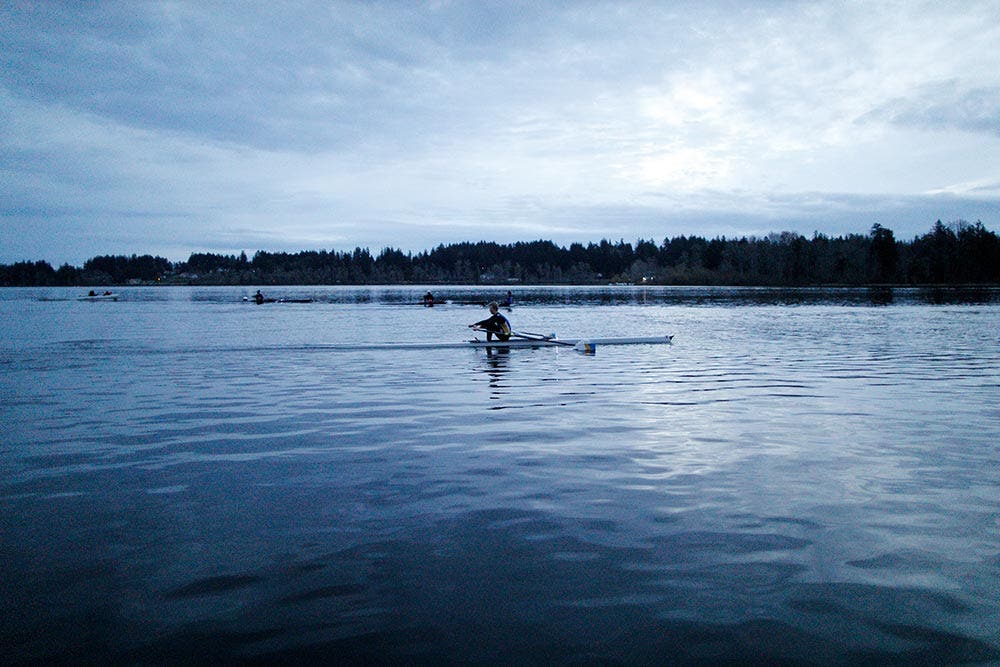Rowing and Weather Matters

Accurate local weather data makes for better decisions regarding rowing safety, practices, and events.
Accurate local weather data helps coaches and athletes make better decisions regarding rowing safety, practices, and events.
You can picture these scenarios. A sculler takes his single out for a row middle of the day or mid-week when no one else is around. The river curves a lot. At the dock, the water is okay despite the wind. A few bends later, and conditions are very different. The wind kicks up whitecaps. Now he is in trouble, swamped by waves and ultimately flipping into the water. Another scenario: an inexperienced coach sends out a junior crew for an after-school row, thinking that it is not that hot. She hasn't considered humidity. It is a hard workout, and some of the kids begin to show signs of heat stress. Or how about when you have to make the call about whether to run an on-water practice or not. A big regatta is coming up, and the athletes have not yet clicked in their crews. The forecast from the city weather station is not promising. The kids end up erging, looking out at perfect water conditions.
Weather and Rowing
Weather matters a lot to rowing. It is a safety issue. Think heat, cold, wind and thunderstorms. Weather impacts training. It is frustrating to keep missing rows due to strong winds in the wrong direction. Boat speed is affected by water temperature and especially wind direction and strength. For fitness and recreational rowers weather certainly affects whether an outing is enjoyable or not. It is a significant consideration for regattas and other events. And yes, rowing is a water sport, but who really likes rowing in the rain?
Weather is a favorite topic of conversation already. Perhaps we should be talking more specifically about weather and rowing. Good information is a powerful tool, and knowing how to use that tool to make better decisions is an important skill.
Start with good local data
Weather conditions reported from the airport station or other area do not necessarily align with conditions at the dock. Weather is very localized. How weather conditions impact your rowing is further complicated by the nature of your local water body. For example, wind pushing against a river current creates very different conditions than wind in the same direction as the current. Weather apps have become more sophisticated but often are not local enough. Sometimes different apps give contradictory information. Club webcams certainly show if it is raining or sunny and whether there are waves or whitecaps. But only on-site measurement provides accurate local weather data.
Rowing clubs or programs are starting to invest in their own local weather stations. Temple University in Philadelphia installed a KestrelMet 6000 Cellular Weather Station on their dock. Kestrel is a division of Nielsen Kellerman. The Station monitors:
- Wind speed
- Wind direction
- Barometric pressure
- Relative humidity
- Temperature
- Rainfall
The KestrelMet is powered by solar energy with a back up battery and relays the information via cellular data transmission to the cloud, allowing real time access to the data and storage. The KestrelMet 6000 is also available with Wi-Fi data transmission for installations where Wi-Fi is an option.
Rebecca Grzybowski, a coach from Temple explains the benefit of the KestrelMet 6000 at the boathouse.
Using local weather information for safety
Safety is the priority. Virtually every national rowing federation and most clubs have weather safety protocols. For example, Indianapolis Rowing Center where Olivia Mencias found her voice coxing, has a safety policy including weather, with an emphasis on heat safety protocols. Rowing Canada Aviron has an online safety course. Completing the course is a requirement of Canadian clubs before a rower can go out on the water. An entire module examines Environment and Weather.
In northern climates, cold water and air and the potential for hypothermia are very real concerns. Cold water cools the body much faster than air, and sudden immersion can cause cold shock, incapacitation and hypothermia. If you are wet and the air is cold, it is also dangerous. Some clubs in the USA use an 80 or 90 degree rule, adding water and air temperature. If this falls below 80 or 90 degrees cold weather rules go into effect. These might include rules such as minimum four oars per boat and rowing only with a safety launch. The KestrelMet 6000 Weather Station will give accurate local air temperature. A simple thermometer can measure water temperature at the dock or further out from a coach boat. The Kestrel 2000 and higher handheld weather meters can be used to obtain accurate water temperatures.
The other extreme of heat and hyperthermia is equally serious. Indianapolis' Heat Index Chart connects categories of heat index with recommendations for outdoor practices, precautions for athletes, and suggested fluid intake for athletes. Concern about heat is not just for rowing. The organizers of the Boston Marathon use multiple handheld Kestrel 5400 WBGT (Wet Bulb Globe Temperature) Heat Stress Trackers to monitor for potential heat stress conditions. Conditions vary along the 42 km course, and hyper local data is needed for decision-making.
Weather and rowing speed and training
Dr. Valery Kleshnev, who partnered with NK Sports in the development of the EmPower Oarlock, is the author of The Biomechanics of Rowing and Founder and Director of BioRow. Weather comes up 13 times in his book and has a featured section near the end. It starts with:
"It is an obvious fact that the boat speed depends on the wind speed and direction and water temperature."
The Australian NK Sports dealer delved into Dr. Kleshnev's data, illustrating the impact of wind direction and speed on a men's single and men's 8+. Differences could be as much as 2 min over 2,000 meters. Water temperature is assumed to influence speed as well. Frank Biller, Director of Rowing at the Virginia Rowing Association, presented data at a coaching conference showing how colder water slows a single, although not as much as expected. He points out that physics does not tell the whole story. For example, when temperatures are lower, rowers are wearing more clothing, and some may carry a little extra weight at that time of year. Colder months are often when low-intensity training takes place. Regardless, accurate local weather data helps to interpret the results that a rower sees for differing split times on their SpeedCoach.

Making decisions about regattas and events
For regattas, decisions around weather are not just about safety but also about fairness. Olympic races in Tokyo and Rio were delayed or completely rescheduled due to weather. These decisions are not taken lightly. The effect on the athletes can be significant, impacting pre-competition preparation, both mental and physical. If a race runs under less than ideal conditions, water and wind conditions can vary markedly amongst the lanes. Fairness Committees make these significant decisions and depend on accurate and local weather information.
Weather data as a learning tool
Clubs and programs for scholastic rowers have one further application for a KestrelMet 6000 Cellular Weather Station on the dock besides better decisions for high school rowing programs. Rowing and weather offer STEM (science, technology, engineering, mathematics) learning opportunities. Dr. Kleshnev has published rowing books filled with STEM concepts in mathematics, physics and kinesiology. The Detroit Boat Club Crew, with Friends of Detroit Rowing created a curriculum teaching middle and high school students science and mathematical concepts through rowing. STEM concepts have also been taught to Philadelphia students using a KestrelMet 6000 Weather Station. So why not put a station on your dock, get accurate local weather and use it as a learning tool for the students? If the data suggests that an on-water practice is unsafe, explain why before you send the kids to the ergometers.
To learn more about the KestrelMet 6000 Weather Station, visit KestrelMet.com.






